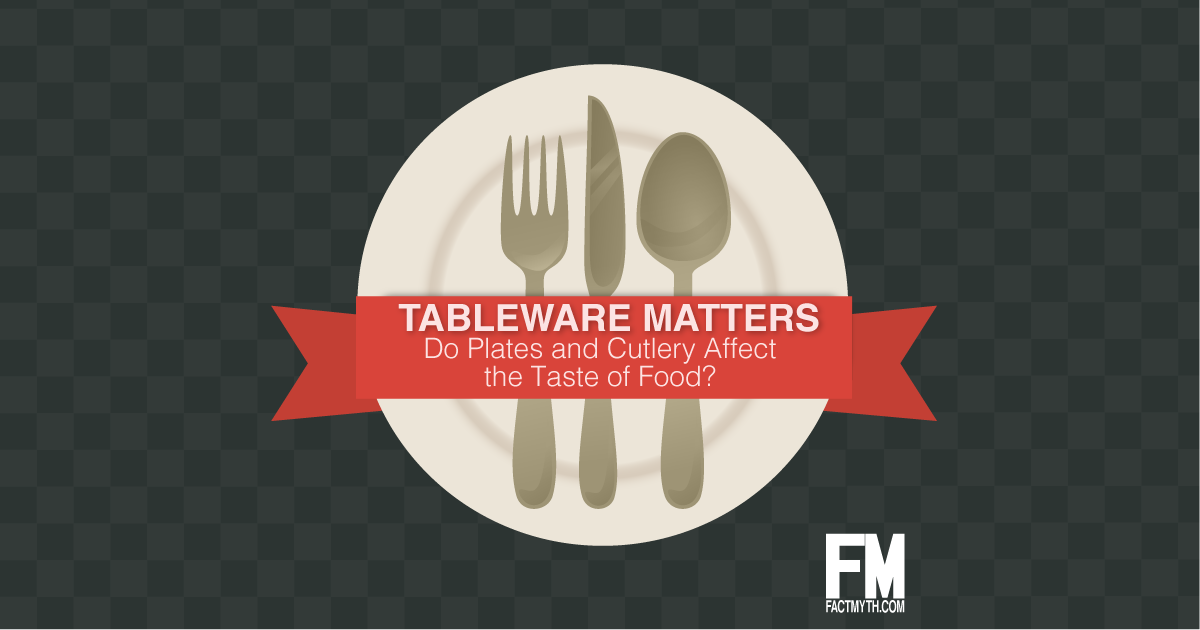Tastebuds are finicky, some people can really taste the cutlery, plates, cups, and other dining utensils. There are many factors that affect taste.
Tableware Affects the Taste of Food fact

Does Tableware (Plates, Bowls, Cups, Cutlery, etc.) Affect the Taste of Food?
According to recent food science, tableware (plates, cups, and cutlery) affect the taste of food as do other factors like color, smell, sound, and weight.
You would think that you could taste the real flavor of food no matter what plate it is served on, or what cutlery you eat it with, but recent research has discovered that these factors, as well as many others, affect its perceived taste. [1]
Qualities such as saltiness or sweetness, as well as an overall enjoyment of eating and the value you think your meal has, all change based on the color, size, and shape of your dishes and the visual and tactile properties of your cutlery.
Why Does Plane Food Taste So Bad?. Some interesting food science, although not directly relating to dining accessories affecting food taste.Recent Food Science tries to Improve Taste.
Food Science research has recently focused on changing the sensory attributes of food to make in more desirable and analyzing the physical processes that are involved in feelings of pleasure and satiety. [2]
With the above said, researching has been done on environmental influences on perceived taste as well.
Neatness vs. Chaos on your Plate Affect Taste.
One important factor that affects the perception of food is whether it is served in a neat or messy manner. Not only do people expect to like neatly presented plates of food, but they also perceived food that was presented in an orderly and pleasing manner to be more pleasant. It is interesting that only animal based food was thought to be of dubious quality when served jumbled together. Vegetables can be mixed with impunity as long as care is taken that the colors and shapes are pleasing. [3]
Serving Size can Affect Taste.
The size of the food serving relative to the size of the plate it is served on influences a diners’ perception of serving size. Restaurants have been making use of an optical illusion, called the Delboeuf illusion [4], of relative size perception for years. People tend to serve themselves small servings on small plates and larger meals on larger plates. The amount of space around the food influences the perception of the quantity of food served.
The Color of Plates may Affect Taste.
Color has a significant influence on food. People tend to serve themselves more on plates that are the same color as the food (for example, spaghetti with red sauce on a red plate) than they do if the plate is a contrasting color (for example, spaghetti with red sauce on a white plate). The color blue tends to suppress appetite while white tends to lead to underestimating the amount one is eating. White foods such as popcorn are said to encourage you to ignore serving size. [5] White plates tend to make food seem sweeter and intensely flavored. [6]
The Color and Weight of Cutlery Affects Taste.
Vanessa Harrar and Charles Spence, writing in the on-line peer review journal Flavour, reported on a set of experiments that they did with subject eating yogurt from various weights of plastic spoons. They discovered that people perceived the yogurt as more expensive and dense when they ate it from a lighter weight spoon. The taste of the yogurt and cheese used in the experiments seemed sweeter to the subjects when eaten from a spoon, and saltier when eaten from a knife. The yogurt also seemed sweeter when eaten with a spoon of a color that contrasted appealingly with the food. For instance, blue bowls or cutlery led the subjects to perceive greater saltiness. [7]
Does Color of Food Affect Taste?. With food, color matters.What Other Factors Affect Taste?
In truth, almost all of our senses, our mood, and perhaps other factors we have not yet focused on can affect taste. Taste is a sensory feedback mechanism with complicated mechanics. Learn more about the senses here.

Source: Modified from USDA.gov
- “Demonstrations of the influence of the eating environment on food acceptance.” Meiselman HL1, Johnson JL, Reeve W, Crouch JE. Appetite. 2000, 35: 231-237. 10.1006/appe.2000.0360
- “Plate Size and Color Suggestibility: The Delboeuf Illusion Bias on Serving and Eating Behavior” foodpsychology.Cornell.edu
- “Neatness counts. How plating affects liking for the taste of food” Sciencedirect.com
- “Delboeuf illusion” Wikipedia.org
- “How Color Affects Your Perception Of Food” Thekitchn.com
- “Plate shape and colour interact to influence taste and quality judgments” flavourjournal.Biomedcentral.com
- “The taste of cutlery: how the taste of food is affected by the weight, size, shape, and colour of the cutlery used to eat it” flavourjournal.Biomedcentral.com
